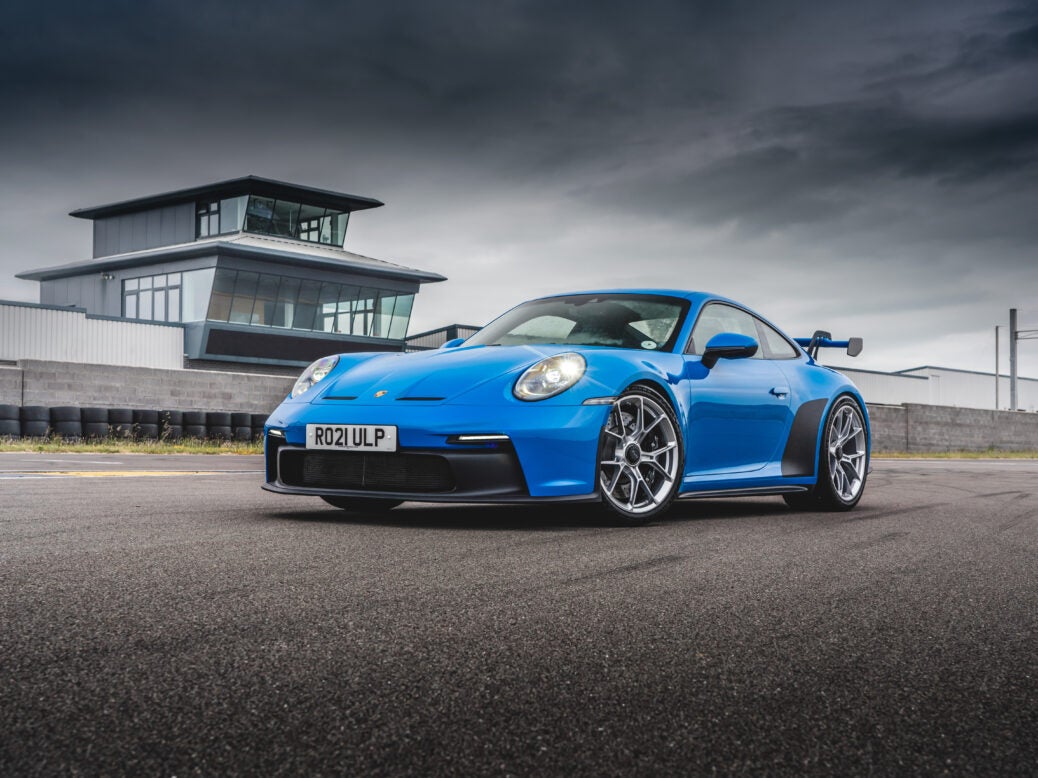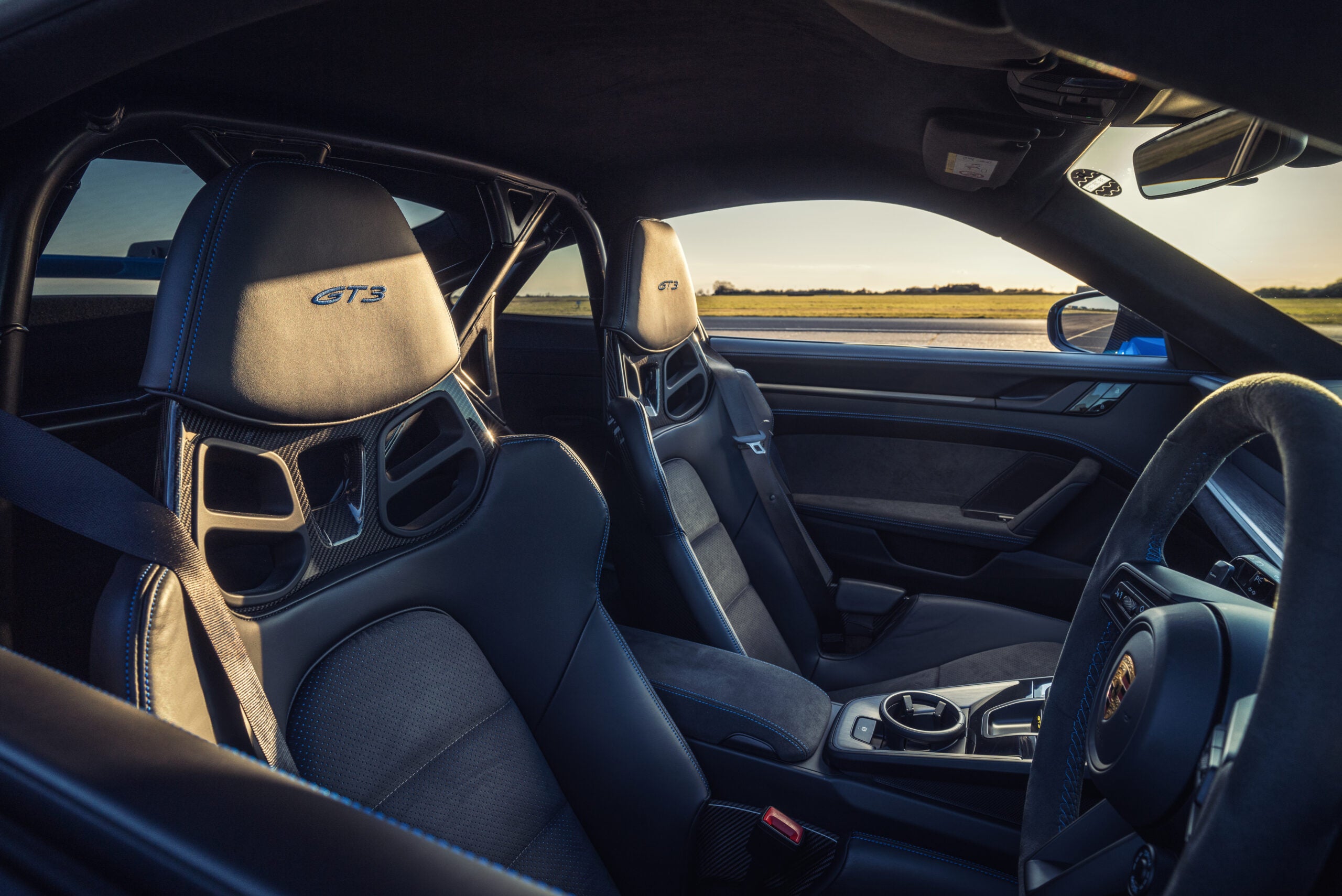
Porsche’s latest 911 GT3 update promises to make supercar drivers fall back in love with the manual gearbox, writes Mark Walton
It’s now 30 years since a Formula One driver won the World Championship with a manual gearbox – it was Ayrton Senna in 1991. Since then, every champion has won the F1 title by flipping an electronic paddle-shift with his fingertips.
That technical revolution was started by Ferrari in 1989, and the brand maintained its lead in 1997 by becoming the first to develop a paddle-shift for a road car, the Ferrari F355 ‘F1’. This was a blessing for supercar manufacturers everywhere – and most owners too – because (whisper it) most supercar owners aren’t really interested in changing gear.
Yes, despite the hairy-chested prestige of supercar ownership, in reality most drivers just want to cruise around. The semi-automatic gearbox is the perfect face-saving option: you can boast about your F1-inspired paddle-shift gear change and how it shaves a few tenths off your 0-60mph time, while driving it in full auto mode the whole time.
Orders for manual gearboxes declined sharply through the 2000s. In 2011, Ferrari stopped offering a manual option in the UK; by 2016, its manual production had ended completely. It’s not surprising when you look at the order book: in the six years the Ferrari 599 was on sale in the UK (2006–12), not a single manual example was ordered. Not one. It seemed the automatic had won.
But then a backlash began. When Porsche released a new edition of its hardcore 911 GT3 in 2013 (codename 991), for the first time it was only available with Porsche’s paddle-shift ‘PDK’ auto. No manual gearbox. This caused outrage. The 911 GT3 represented the ultimate driver’s car, the pinnacle of challenging, hardcore driving. Showboating Ferraris and look-at-me Lamborghinis were one thing; for the GT3 to go auto was heresy.
Porsche stood firm for a while but, off the record, even Porsche’s engineers seemed to miss the manual. Later, the head of the GT3 programme, Andreas Preuninger, admitted: ‘For the driver who really likes to think, be challenged, and wants to be an integral part of the drivetrain, the manual provides a very satisfying experience.’
So when the next GT3 facelift came around in 2017 (codename 991.2), Porsche relented and once again offered both manual and PDK options. It was a big test – not just for Porsche, but for all of us. As enthusiasts, had we really lost the appetite for clutch pedals and gear levers? Was there still a market for analogue driving?
In the end, the take-up of the GT3 manual was 30 per cent globally; in the US it was 70 per cent. Seems you don’t appreciate what you’ve got until it’s about to go extinct, and suddenly the manual had cult appeal.
It’s in this context that the new 911 GT3 has been launched (codename 992). There’s a new ‘standard’ PDK semi-automatic GT3 with paddles; and then there’s this, the much anticipated, wilfully defiant, stick-it-to-the-man manual.
As well as continuing to fly the flag for the manual gearbox, the new 992 continues other GT3 traditions. There’s the gigantic rear wing, the bonnet vents, wide arches, and huge, centre-lock alloy wheels. That wing is made from lightweight carbon, as is the bon[1]net. The windows are a special lightweight glass and there are no rear seats. Altogether, the GT3 is almost 100kg lighter than the standard 911.
Under the skin there’s another massive change. It’s one you can’t see but it defines the way this car drives: the 992 GT3 is the first 911 road car to have double-wishbone front suspension. I won’t go too geeky on the technical detail, but this set-up is a huge deal, allowing more stiffness (for handling and grip) while maintaining comfort.
Inside, the interior has been updated with the latest generation colour screens, but the focal points of a GT3 are those three touch points: the seats; the steering wheel; and that gear lever, its simple yellow graphic showing the six-speed layout. The PDK version gets seven speeds, but who cares. Wiggle the lever from side to side and it clacks against hard metal confines. It feels tight, like the bolt action of a rifle.
The 503bhp flat-six engine starts with a fast, mechanical whirr, and when you dip the clutch and pull away, this is anything but a scary car. That clutch is lighter than previous GT3s – quite a long travel but smoothly sprung. And the steering: a lot of sporty cars have deliberately stiff steering, engineered to suggest meaty grip. The 992 GT3’s steering is direct, and with four-wheel steering the turn-in has a razor-sharp resolve; but it’s also surprisingly light. Combined with the front suspension, that lightness makes the new GT3 feel so controlled, so accurate, so at ease with itself. It’s comfortable, despite being stiff, swallowing bumps and sticking to its line. Within a few miles, you feel full of confidence.
Now switch from Normal to Sport mode, pick up the speed, and everything turns joyously manic. The engine noise – louder than in previous generations – fills the cabin with a wild, orchestral howl. And this race-derived engine winds up to an incredible 9,000rpm – at such high revs, it’s like there’s a caveman in the back seat, blowing into a seashell horn. Every hair on your neck stands up.
In the centre of all this is the gear change. As Preuninger said, ‘for the driver who wants to be an integral part of the drivetrain’. You, the human being, are at the heart of the mechanical action, hand-delivering the might of that engine to the rear wheels through a stubby lever. In the middle of a brutally quick lunge down a straight, you get to choose the moment to snatch from third to fourth; you get to blend the revs, pedals, arms and legs all coordinating to make the change as seamless as possible. It’s so absorbing, so satisfying when you get it right. And the effect each change has on the sound – punctuating that wailing cry, initiating the next sonorous climb – it makes you feel like the conductor in a ferociously intense theatrical performance.
The new 992 GT3 is the best yet. It’s not the most powerful car in the world, nor is it the fastest or the most beautiful; but it represents a driving ideology, a purity of purpose. The manual gearbox belongs at the heart of that philosophy. One day, electric cars will be the norm and there won’t be gears any more; there might not even be a steering wheel. But while there are still engines and while we can still truly drive, we still need clutch pedals and gear levers. One short drive in the new 911 GT3 and you’ll feel it in your bones: the manual gearbox deserves to survive.







